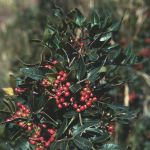| Common Name: |
Mastic Tree |
| Other Names: |
Lentisc |
| Botanical Name: |
Pistacia lentiscus |
| Genus: |
Pistacia |
| Family: |
Anacardiaceae |
| Native Location: |
Mediterranean |
| Cultivation: |
Well-drained to dry, sandy or stony, alkaline soil in sun. Trim plants in spring to restrict size. |
| Propagation: |
By seed sown at 25°C (77°F) in early spring; by greenwood cuttings in late spring or early summer; by semi-ripe cuttings in summer. |
| Harvest: |
Resin is obtained from incisions in bark from mid-summer to mid-autumn, and dried for powder (P. lentiscus) or distilled for oil and essence (P. lentiscus, P. terebinthus). Seeds are pressed for oil when ripe. |
| Height: |
1-4m (3-12ft) |
| Width: |
1-4m (3-12ft) |
| Hardiness: |
Z9 |
| Parts Used: |
Resin, Oil |
| Properties: |
An aromatic, stimulant, antiseptic herb with a pine-like aroma. It has diuretic and expectorant effects, and controls bleeding. |
| Medicinal Uses: |
Externally for boils, ulcers, bronchitis, ringworm, and muscular stiffness. |
| Culinary Uses: |
Licorice-flavored resin is chewed like chewing gum, and used to flavor cakes, desserts, and candy. Oil from seeds, known as shina oil, is used for cooking. |
| Economic Uses: |
Resin and oil are used as fixatives in perfumery and also in the Greek candy masticha and in the liqueur mastiche. Resin is used in varnishes, lacquers, and for sealing edges of microscope mounts. |
| Bibliography: |
Encyclopedia of Herbs by Deni Brown Copyright © 1995, 2001 Dorling Kindersley Limited pp.321-322 |

